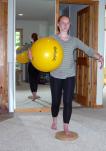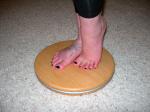Cognitive awareness of the subtle shifts of weight on the pelvis can make a difference between being able to sit upright or collapsing into twisted slumping. Implementing this proper pelvic alignment in a seated position requires each individual to consciously recognize where the weight shifts on each of the ischial tuberosities or sit bones If your client can experience the various options of front/back, side/side, and right/left of the pelvis movement repertoire, then choosing “center” becomes a relative position and easier to replicate. These learned proprioceptive skills can correct dysfunctional patterns, reduce back pain and create body symmetry with improved muscular balance.
Unhook all of the springs on the Reformer and instruct your client to sit on the edge of the carriage on a medium-sized 12″ rotator disc facing the footbar holding a medium-size dowel across the sacrum. Advise your client to be careful when sitting down since the carriage has the potential to slide away without the springs. If your client is too short, you may require the use of yoga blocks or some other prop to bring the legs to a 90-degree angle.
“1. Place a hand on the sacrum, and detect the bumps on the back of the bone. These bumps are the spinous processes of its five fused vertebrae. To feel the movement of the sacrum, it is easier to touch the adjoining bones that are easy to feel under the skin, the tailbone and the lumbar spine.
2. Place the middle finger of one hand on the tip of the tailbone, and place the middle finger of the other hand on the spinous process of the fourth or fifth lumbar vertebra.
3. Tilt the pelvis forward, and notice how the lumbar spinous processes move forward and the tail moves back. The sacrum is doing a forward rotation movement called nutation (deriving from the Latin for nodding.) At this point the sacrum is only doing the first half of a nod…
4. Tilt the pelvis backward, and notice how the sacrum moves back and up. This movement is called counternutation, the second half of the nod…
5. Tilt the pelvis forward again and notice that nutation is linked with the spreading of the sit bones.
6. Tilt the pelvis backward, and notice that counternutation is linked to the converging of the sit bones.
7. Notice that nutation causes the lumbar spine to extend (the feeling is hollowed spine), while counternutation causes the lumbar spine to flex (the feeling is rounded spine).”
To give my clients the feeling of the pelvis as a whole, I describe an anterior pelvic tilt (sacral nutation) as a “Christmas tree” with a wider base at the sit bones and narrower feeling at the top of the pelvis (ilium) and a posterior pelvic tilt (sacral counternutation) as a “funnel” with a narrower base and a wider feeling at the top of the pelvis.
The benefit of being on the Reformer without springs is that the carriage should move slightly backward in the anterior pelvic tilt and forward toward the calves in the posterior pelvic tilt. If the carriage does not move front and back, then the initiation of the movement is incorrectly occurring at the rib cage instead of being driven by the pelvis. The dowel also assists in helping your client observe and feel the shifting pelvis. Notice if your client tends to put more weight on one sit bone or the other when moving, but do not mention it yet.
After moving a few times between the front and back positions have your client find neutral pelvis (in between the practiced positions) with the weight slightly forward on the sit bones (ischial tuberosities) and the feet weighted on the floor. In the neutral pelvis position, there is a equal activation of the transversus abdominis in the front of the waist and the lumbar multifidus in the low back to create an equal supported lift much like squeezing toothpaste from both sides on the bottom produces the lift out the top. This abdomen/low back gentle lifted squeezing can also be felt at the sides of the pelvis. This comfortable lifted synching feeling (much like pulling the string to tighten a duffel bag) is important to hold and maintain the neutral pelvis position once it is located and experienced.
Ask your client to be in this neutral position with the least amount of effort. If there is excessive muscular tension held in the body, then proper placement cannot be maintained over time. Help your client find the relaxed supported placement that can be held habitually. (See “The Use of Imagery to help Your Client Find Lift Through the Core.” for ideas about helping your client feel core engagement through imagery.)
Repeat the exercise again and have your client notice the weight on each sit bone while rocking front to back. Have your client put more weight on the right side, then the left, followed by weight equal in the center. The hard rotator disc makes this easier for your client to feel shifts of weight. If you previously noticed your client shifting more weight to one sit bone in the exercise, ask him/her if one side or another is more comfortable and see if it correlates to your previous observation.
If your client tends to sit toward one side, suggest that he/she check in throughout the day to see if this is a habit. Your client is best equipped to make this correction and develop the new habit through conscious attention and a commitment to change.
After about 5 sets, have your client now try to lift the ribcage laterally to the right while sitting up tall, keeping weight on BOTH sit bones. Have your client observe now that both sides of the lumbar multifidi are activated—it is like having two “rocket boosters” (one on each sit bone) to lift the ribcage off the pelvis instead of one. This equal activation creates a more powered balanced lift.
It may be difficult for your client to keep both sit bones weighted in the lateral ribcage shift. Suggest that the bones of the pelvis are like a boat weighted in the water. Keep the boat heavy while the muscles and flesh lift upward into the lateral shift much like the vertical mast. You may see a crossover from the previous exercise. For example, if you client felt more comfortable with the weight on the right sit bone moving front to back, he/she may tend to lift the left sit bone as the ribcage moves sideways to the right since it is not used to bearing weight.
The client is sitting on a moving rotator disc so that lumbar rotation of the pelvis is proprioceptively accentuated. Driving the disc is somewhat like moving the wheel of a car: pulling down on the wheel to make a right hand turn would cause the left side of the wheel to move upward, much like moving the right sit bone backward to rotate the disc clockwise would move the left sit bone forward to further rotate the disc clockwise. Have your client rotate the disc to the right while keeping both knees still and holding the Reformer carriage in place. Most people will shift to one sit bone on rotation so instruct your client to drop the lifted sit bone (“sit the boat in the water”). Be sure to initially isolate pure lumbar rotation by keeping the chest facing forward in place. Repeat to the other side. Watch to be sure your client keeps weight on both feet as there is a tendency to roll one knee inward during the exercise.
After your client experiences moving the disc in rotation, add the thought of siting tall during this twist and to engage the transversus abdominis (lower abs) and lumbar multifidus (low back muscles) so that there is a feeling of lifting upward through the spine. Just as it is necessary to bend the knees and go into the floor prior to jumping, the pelvis must first be weighted on the disc in opposition to the lifted ribcage. Both “rocket boosters” (ischial tuberosities) should be connected in a centered pelvis giving more power to the lift since both sides of the back will be active.
Now move the pelvis, chest and head in succession during the rotation. It should feel like a spiral staircase moving upward. Notice if the ribcage moves laterally off the pelvis during rotation and indicate the necessary correction to bring the ribcage centered over the pelvis—if the ribcage is shifted, odds are that one sit bone will also be lifted. Just as in stacking blocks, the lumbar and thoracic sections of the spine are structurally solid on top of each other, rather than precariously stacking on the counterbalanced edges.
Conscious and attentive self-awareness of pelvic placement in a seated position can improve overall posture. Just as a building needs a good foundation, the spine’s structural integrity is dependent upon a solid base. Your client can create new sitting habits, but must first have the knowledge and experience of how to find center. The best way to experience center is through its contrast of shifting weight off-center. Once the relative position of center is understood, and the weight over the ischial tuberosities felt, your client can consciously maintain balanced alignment through daily practice.


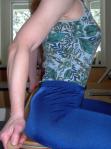

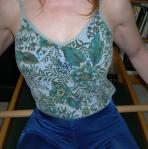




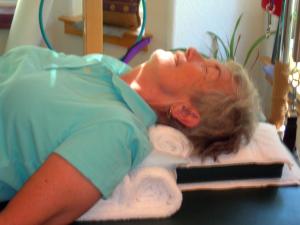


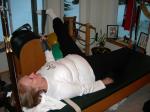


 The placement of the arms should be considered in the turn. You can have your client hold her arms by her sides or in front of her as if she is holding a ball. If you have a ball that is the size of a beach ball it can be useful to actually hold the ball at the chest. Note that your client might feel more secure having her arms free when first attempting this exercise in case she loses her balance.
The placement of the arms should be considered in the turn. You can have your client hold her arms by her sides or in front of her as if she is holding a ball. If you have a ball that is the size of a beach ball it can be useful to actually hold the ball at the chest. Note that your client might feel more secure having her arms free when first attempting this exercise in case she loses her balance.